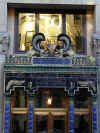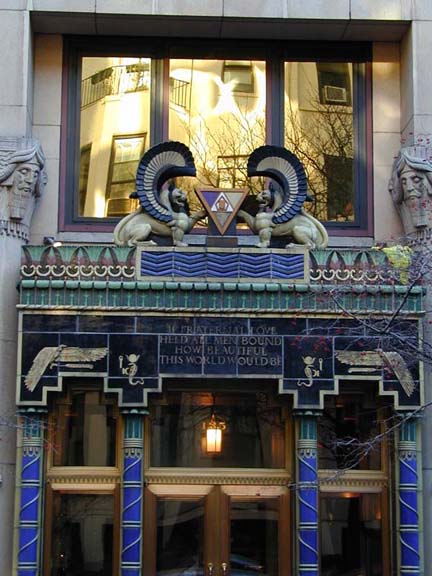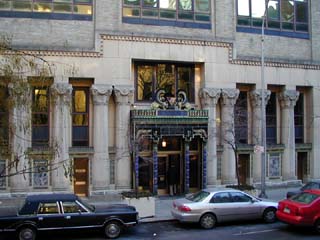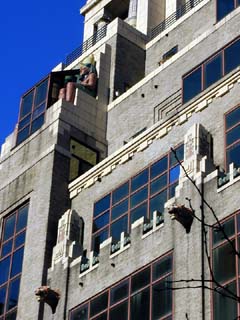 |
New York
Architecture Images-Upper West Side The Pythian |
|
architect |
Thomas W. Lamb |
|
location |
135 West 70th Street |
|
date |
1927 |
|
style |
Art Deco |
|
construction |
Floors: 11 Condominium 88 Apartments |
|
type |
Apartment Building |
|
|
|
|
images |
 |
|
|
  |
|
notes |
"Hollywood may have had its Grauman's Chinese, but New York has its Pythian Temple! Hidden on an anonymous side street, this opium-smoker's dream is best seen from across the street- or better still from someone's upper floor-apartment to the south," wrote Elliot Wilensky and Norval White in the excellent book, "The A.I.A. Guide to New York City, Third Edition," (Harcourt Brace Jovanovich, 1988). August 24, 2003 Recalling the Days of Knights and Elks By CHRISTOPHER GRAY The former Pythian Temple on West 70th now houses apartments. TO many in New York, the former Board of Education headquarters at 110 Livingston Street in Brooklyn is emblematic of a bloated bureaucracy. But to architectural historians, the Italian Renaissance-style building, designed by the renowned firm of McKim, Mead & White, represents a special period of real estate optimism in the 1920's when fraternal lodges thought they could join the building boom and secure their financial futures. For almost every one of them — the Elks, the Masons, the Knights of Columbus and just about any group with many dues-paying members — the rosy projections ended in less than a generation. But the remnants of their dreams remain part of the city streetscape. In the case of Lodge 22 of the Benevolent Protective Order of Elks, which built the 13-story 110 Livingston Street in 1928 at Boerum Place, the sojourn in the building lasted less than a decade, until 1936, when the group sold it to New York City for new, centralized Board of Education offices. For the Masons and their 17-story Level Club, designed in 1926 for a site behind the Ansonia Hotel on West 73rd Street just west of Broadway, the dream lasted four years. The club went into foreclosure in 1930, became a hotel in 1936 and was converted to apartments in the 1980's. For the Knights of Pythias and its show-stopping 1926 Pythian Temple at 135 West 70th Street — with its colorful midblock facade of movie-set Egyptian forms and seated Pharaonic figures — it lasted until the 1950's, when the building was sold to a school. (It too was converted to apartments in the 80's.) The seeds for such projects were sown in the 1890's, when the advent of high-rise construction changed the economic landscape for real estate developers, permitting them to use the economics of concentration for both commercial and residential buildings. Other owners gradually followed. High-rise hospitals began appearing around 1900, and a few social clubs and fraternal organizations built tall structures in the 1910's, like the 19- and 20-story lodge and office complex that the Masons built in two parts in 1909 and 1912 at 23rd Street and Sixth Avenue. But the boom years of the 1920's accelerated the pace of such projects, including some that seemed financially doubtful. One of the first was the Fraternities Club, designed in 1922 and completed in 1924 at the southeast corner of 38th Street and Madison Avenue. An adjunct of the Allerton Hotel chain, the 38th Street building was put up for members of college Greek-letter organizations. Designed by Murgatroyd & Ogden in a medieval Italian style, the 17-story building had meeting rooms for 16 college fraternities, like Delta Phi and Kappa Alpha, along with 560 guest rooms. In effect, it was really a very specialized hotel. The Cornell Club, a tenant, had an expansive set of rooms on the 12th and 13th floors, with a double-height lounge and murals of the Ithaca, N.Y., landscape. The Clergy Club was also a tenant. Thus, in 1930 some of the most prominent ministers in the city were embarrassed — or perhaps only inconvenienced — to find that prohibition agents had masqueraded as college men for several weeks and then conducted a raid at the building. They confiscated 101 bottles of liquor, with a result that the entire building was threatened with closure, although it is not clear whether that happened. In 1923, 42 Manhattan and Bronx councils of the Knights of Columbus — the fraternal order for Roman Catholic men — began raising $3 million for a 15-story building; it was completed in 1927 at the southeast corner of Eighth Avenue and 51st Street. Designed by Edward F. Fanning, the building had an auditorium for 1,800, council rooms, restaurants and athletic facilities like a running track atop the building. Cardinal Patrick Hayes blessed the cornerstone in 1925, when 10,000 members, most wearing straw hats, blue serge coats and white flannel trousers, paraded from 76th Street and Central Park West to the site. The finished building had the names of Marquette, La Salle, Columbus and other Catholics important in the history of the country inscribed on its facade. The Knights of Columbus in Brooklyn laid the cornerstone for its nine-story building at 1 Prospect Park West, and the structure was completed in 1925. The New York Times reported that Mayor John F. Hylan praised the Knights for "fostering that natural impulse toward good citizenship, which is so sorely tried by the distractions and temptations that beset our young people." The group borrowed $750,000 against the $1.2 million cost, but the Knights were building not just for their own use but also for income. The magazine Architecture and Building wrote in 1925 that the banquet hall, 198 rooms (at $35 per month) and the 2,000-seat auditorium were intended to be used by outside parties, which would generate rental income. The same economic optimism was in play with the Level Club on West 73rd. Founded in 1919 by a few Masons, the Level Club had been doing fine in a small building on St. Nicholas Avenue. The budget was increased to $3 million from $1.7 million before ground was broken. Apparently, the prospect of the country's Masons staying in the 350 bedrooms seemed persuasive, along with a projected future New York membership of 5,000. Designed by Clinton & Russell/Wells, Holton & George, the Romanesque-style facade spills down a waterfall of dramatic setbacks, with picturesque towers rising up like boulders in a stream. The 28-foot-high lobby was movie-theater baroque, with heavily colored and richly veined marble, and huge trusses supported the upper floors above the auditorium on the fourth and fifth floors. The Knights of Columbus buildings were tepid works, with little more character than a typical speculative project, but the Levelers built one of New York's most dramatic midblock structures. In 1927, Lodge 22 of the Brooklyn Elks began its own ambitious 13-story headquarters at Livingston Street and Boerum Place in Brooklyn, issuing $2.9 million in bonds. McKim, Mead & White designed a mild Italian Renaissance-style structure, solid but with little drama, except for the head and shoulders of an elk in bronze set into a cartouche over the main doorway. In 1929, a developer, Abraham H. Spiegelgas, who had lost heavily in the stock market, took one of its 250 rooms just before he was due in court to answer charges of misappropriation of funds. He killed himself in Room 725. The Times noted that he had left an apology to the Elks, and the context implies he was not actually a member, suggesting that the lodge may have been renting its rooms to the public. Another lodge building begun in 1926, the $2 million Pythian Temple on West 70th Street, was for the local chapter of the Knights of Pythias, a fraternal order founded in 1864. The theater designer Thomas Lamb created a midblock facade of movie-set Egyptian forms, seated Pharaonic figures, polychrome columns and a setback arrangement similar to that of the Level Club. Inside, there were 13 lodge rooms and an auditorium decorated in a striking Egyptian manner. A news report on a 1928 dinner by a group called the Women's 13 Club — with smashed mirrors, spilled salt and black cats — suggests that the Pythians also found it necessary to venture beyond the fraternal bonds for rental income, and by the 1930's they were certainly leasing the auditorium for religious and political meetings. Other nonfraternal organizations also joined the 1920's rush to build up. The venerable New York Athletic Club built its reserved clubhouse on Central Park South and Seventh Avenue in 1928. The Explorers Club, founded in 1904, built an eight-story clubhouse at 544 West 110th Street in 1928. And the Downtown Athletic Club, a businessmen's organization founded only in 1926, built a 38-story Art Deco building at 19 West Street with 143 rooms for its 3,826 members in 1930. The crash of 1929 was tough on discretionary real estate like club facilities, but even before the crash there had been signs that this kind of improvement was hyperinflated. In April 1929, the Knights of Columbus in Manhattan denied to The Times that the Eighth Avenue clubhouse was for sale — only to announce in the fall that they had reached a deal to radically alter their auditorium into a bus terminal. By the late 1930's the Knights were holding on to a few rooms, but most of the building was owned by a hotel operator. In 1930, the Level Club went into foreclosure — only the first installment on its $2.2 million mortgage had been paid, in 1928, indicating that it was in trouble right from the beginning. In 1936, it became a conventional hotel. The Fraternities Club on Madison Avenue was turned into a businessmen's hotel in 1931. The fraternities, evicted, said they were going to build their own structure, but no such project went ahead. In Brooklyn, the Elks began to miss payments on their bonds, and bondholders pressed for their money in 1932. The Elks hung on until 1936, when the city bought the building for new, centralized offices for the Board of Education, at that time with 2,400 employees spread around four offices. The sale angered the committee of bondholders — who got only 10 cents on the dollar. And the move was not without conflict at the Board of Estimate, whose approval was required. At the last minute the borough presidents of the Bronx, Queens and Manhattan temporarily blocked the move, apparently miffed that Brooklyn was getting such a prize. But Henry Turner, president of the Board of Education, noted that Brooklyn had 40 percent of the city's school population and that the move would be "a direct contribution toward the increase in efficiency in administering the affairs of the school system by bringing under one roof its presently scattered bureaus." The city bought the building for $955,000, less than a third of its cost only eight years before, and even then half of the purchase price was simply the payment of a bill for back taxes. In 1937, a final sale of the Elks furnishings cleared the building, and in 1939 the architects Schultze & Weaver made sweeping alterations, erasing most of the Elks' majesty in favor of office space. THE Knights of Columbus in Brooklyn remained in place until foreclosure in 1948, and the Pythians held on to their Egyptian-style building until 1958, when it was sold to a school, the New York Institute of Technology — although the Pythians had already been renting out its biggest auditorium to Decca Records for several years. The nonfraternal high-rise builders had a better track record after the crash. The Explorers Club lost its clubhouse on 110th Street in 1932, but the Downtown Athletic Club held on to its building until two years ago, despite some very rocky years in between. And the New York Athletic Club still has its Central Park South headquarters. It may have been that the Knights of Columbus, the Pythians, the Elks and others were hampered by their very fraternal character. In 1931, Dr. F. W. Mueller of the Methodist Episcopal Church told The Times that the age of high-rise churches was also over. He said that the principal problem was that the churches were at a disadvantage compared with typical property owners, their ostensibly nonprofit character leading to a "difficulty in collecting rents." The fraternal vows expressed in the lodge and council rooms may have compromised the hard-nosed financial dealings needed in the new world of the 1930's. In a new century, the fraternal high-rises have settled into the cityscape. The Knights of Columbus building in Brooklyn, now the Castle at Prospect Park, a residence for the elderly, is hardly discernible as anything more than another 1920's building. Its sibling building, on grimy Eighth Avenue, looks like a fringe-area hotel, although out-of-town guests must sometimes wonder about the memorial inscriptions on the facade. The Level Club and the Pythian Temple are still striking enough to cause people to stop and stare, but both were converted into apartments in the 1980's. They lost most of their surviving grand interiors, and the blank facades and giant cross-trusses through the middle of the buildings posed particular problems in the conversions. As for 110 Livingston Street, it has been routinely showered with epithets that go far beyond any architectural vices or virtues of the old Elks building. Indeed, its address is far more widely known than the building itself, which has the silent gravitas of a Federal Reserve Bank. According to Jerry Russo, a spokesman for what is now the Department of Education, the 800 employees from 110 Livingston Street are being transferred to the restored Tweed Courthouse, right behind City Hall, and 65 Court Street in Brooklyn. Earlier this year, the city sold 110 Livingston for $45 million to a developer, David Walentas, who plans a 245-unit condominium conversion. Passers-by can see the old "BPOE" monogram in the ironwork, which was deftly converted to "BOE" in the 1930's. The Masons, Elks and other groups have generally forgotten their real estate flings of the Roaring Twenties. Elks Lodge 22 now meets periodically in a rented storefront at 7210 New Utrecht Avenue in Brooklyn usually invisible behind a heavy roll-down gate. When they left 110 Livingston Street, the Elks — or someone — removed the bronze figure of an elk from the cartouche over the doorway; it was replaced with an appropriately educational relief of an open book over a lighted torch. The whereabouts of the original bronze is unknown, but it is not visible on Lodge 22's current headquarters. However, over the storefront is a brightly colored sign, with a fair rendering of an elk — in paint. A detail of the Level Club, built by Masons, on West 73rd; the building is now apartments. |
|
links |